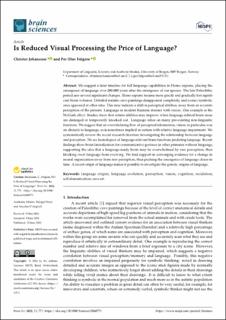Is Reduced Visual Processing the Price of Language?
Journal article, Peer reviewed
Published version

Åpne
Permanent lenke
https://hdl.handle.net/11250/3027990Utgivelsesdato
2022Metadata
Vis full innførselSamlinger
Sammendrag
We suggest a later timeline for full language capabilities in Homo sapiens, placing the emergence of language over 200,000 years after the emergence of our species. The late Paleolithic period saw several significant changes. Homo sapiens became more gracile and gradually lost significant brain volumes. Detailed realistic cave paintings disappeared completely, and iconic/symbolic ones appeared at other sites. This may indicate a shift in perceptual abilities, away from an accurate perception of the present. Language in modern humans interact with vision. One example is the McGurk effect. Studies show that artistic abilities may improve when language-related brain areas are damaged or temporarily knocked out. Language relies on many pre-existing non-linguistic functions. We suggest that an overwhelming flow of perceptual information, vision, in particular, was an obstacle to language, as is sometimes implied in autism with relative language impairment. We systematically review the recent research literature investigating the relationship between language and perception. We see homologues of language-relevant brain functions predating language. Recent findings show brain lateralization for communicative gestures in other primates without language, supporting the idea that a language-ready brain may be overwhelmed by raw perception, thus blocking overt language from evolving. We find support in converging evidence for a change in neural organization away from raw perception, thus pushing the emergence of language closer in time. A recent origin of language makes it possible to investigate the genetic origins of language.
